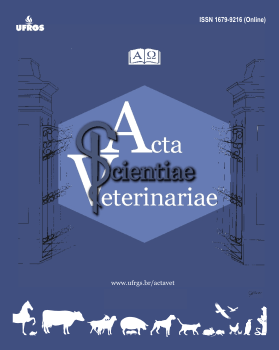Idiopathic Neuritis of the Trigeminal Nerve in a Dog
DOI:
https://doi.org/10.22456/1679-9216.97853Abstract
Background: Idiopathic trigeminal neuropathy is a peripheral neuropathy whose clinical signs include inability to close the mouth. A neurological examination reveals mainly flaccid paralysis of the masticatory muscles, which may be accompanied by atony/hypotonia of the masseter and temporalis muscles. Altered sensitivity may also be present in very rare cases. This article reports a case of idiopathic trigeminal neuropathy with involvement of the motor and sensory nerve fibers in a dog, describing the clinical symptoms, neurological findings, exclusion of other diseases, and evolution of the condition.
Case: A 5-year-old bitch showing signs of difficulty in picking up food, swallowing water, and hypersalivation was taken to a veterinary clinic. According to her owner, these signs had started spontaneously 2 days earlier. A physical examination of the animal revealed only a persistently open mouth, although the mouth opening and closing movements could be performed manually by manipulating the jaw. The patient showed swallowing ability, and her tongue movements were intact. The neurological examination revealed that the animal also presented bilateral absence of nasal sensitivity and absence of palpebral reflex. The animal’s blood test results showed changes only in the CK and AST levels, which were 1,182.60 U/L (reference: 1.5 to 28.4 U/L) and 87.1 IU/L (reference: 6.2 to 13 IU/L), respectively. The animal tested negative for distemper, leishmaniasis, toxoplasmosis and neosporosis. Abdominal ultrasound and thoracic radiography were performed to investigate neoplasia, as well as radiography of the temporomandibular joints, and none of these imaging tests revealed any alterations. A cerebrospinal fluid (CSF) analysis was also within the normal range of reference parameters. In view of the possibility of idiopathic trigeminal neuropathy, prednisolone (Prediderm® 10 mg) was prescribed, to be administered orally in a dose of 0.5 mg/kg at 12 h intervals for 2 days. In addition, the owner was told to provide supportive care by feeding the animal a pasty diet placed directly in the back of its mouth, using a syringe if necessary. An examination of the animal in a follow-up visit to the veterinary clinic 14 days later found that she had recovered completely from her initial condition.
Discussion: Among the most common causes of neurogenic flaccid paralysis of the masticatory muscles is idiopathic trigeminal neuropathy, although trigeminal neuropathy secondary to neoplasms and infectious or parasitic diseases may also occur. Because its etiology is of unknown origin, it is essential to exclude other causes of peripheral neuropathies. Moreover, this disorder is characterized by its self-limiting evolution, with spontaneous cure of the clinical condition within two weeks, as was observed in the case reported here. The absence of nasal sensitivity is not usually found in dogs diagnosed with idiopathic trigeminal nerve paralysis. In this case, however, there was involvement of the motor and sensory fibers, since, in addition to flaccid paralysis of the masticatory muscles, nasal sensitivity was also found to be affected. The condition can be treated with corticosteroids when it first appears, simply in order to hasten the animal’s recovery from the disorder. In addition, given the animal’s inability to close its mouth, it is essential to provide supportive care by feeding it with pasty foods and water by hand to ensure it receives adequate nutrition during the course of the disorder.
Downloads
References
Center S.A. 2007. Interpretation of liver enzymes. Veterinary Clinics of North America: Small Animal Practice. 37(2): 297-333.
Ettinger S.J. & Feldman C.E. 2010. Textbook of Veterinary Internal Medicine. 8th edn. St. Louis: Elsevier Saunders, 2736p.
Greene C.E. 2015. Doenças Infecciosas em Cães e Gatos. 4.ed. Rio de Janeiro: Guanabara Koogan, 1404p.
Getty R., Sisson S. & Grossman J.D. 1986. Anatomia dos Animais Domésticos. 5.ed. Rio de Janeiro: Guanabara Koogan, 2048p.
Giannuzzi A.P., Ricciardi M., De Simone A. & Gernone F. 2017. Neurological manifestations in dogs naturally infected by Leishmania infantum: descriptions of 10 cases and a review of the literature. Journal of Small Animal Practice. 58(3): 125-138.
Mayhew P.D., Bush W.W. & Glass E.N. 2002. Trigeminal neuropathy in dogs: a retrospective study of 29 cases (1991-2000). Journal of the American Animal Hospital Association. 38(3): 262-270.
Pumarola M., Añor S., Borràs D. & Ferrer I. 1996. Malignant Epithelioid Schwannoma Affecting the Trigeminal Nerve of a Dog. Veterinary Pathology. 33(4): 434-436.
Prada I. 2014. Neuroanatomia Funcional em Medicina Veterinária com Correlações Clínicas. Jaboticabal: Terra Molhada, 616p.
Pfaff A., March P. & Fishman C. 2000. Acute bilateral trigeminal neuropath associated with nervous system lymphosarcoma in a dog. Journal of the American Animal Hospital Association. 36(1): 57-61.
Shultz R.M., Tucker R.L., Gavin P.R., Bagley R., Saveraid T.C. & Berry C.R. 2007. Magnetic resonance imaging of acquired trigeminal nerve disorders in six dogs. Veterinary Radiology & Ultrasound. 48(2): 101-104.
Thrall M.A., Weiser G., Allison R.W. & Campbell T.W. 2015. Hematologia e Bioquímica Clínica Veterinária. 2.ed. Rio de Janeiro: Guanabara Koogan, 688p.
Published
How to Cite
Issue
Section
License
This journal provides open access to all of its content on the principle that making research freely available to the public supports a greater global exchange of knowledge. Such access is associated with increased readership and increased citation of an author's work. For more information on this approach, see the Public Knowledge Project and Directory of Open Access Journals.
We define open access journals as journals that use a funding model that does not charge readers or their institutions for access. From the BOAI definition of "open access" we take the right of users to "read, download, copy, distribute, print, search, or link to the full texts of these articles" as mandatory for a journal to be included in the directory.
La Red y Portal Iberoamericano de Revistas Científicas de Veterinaria de Libre Acceso reúne a las principales publicaciones científicas editadas en España, Portugal, Latino América y otros países del ámbito latino





